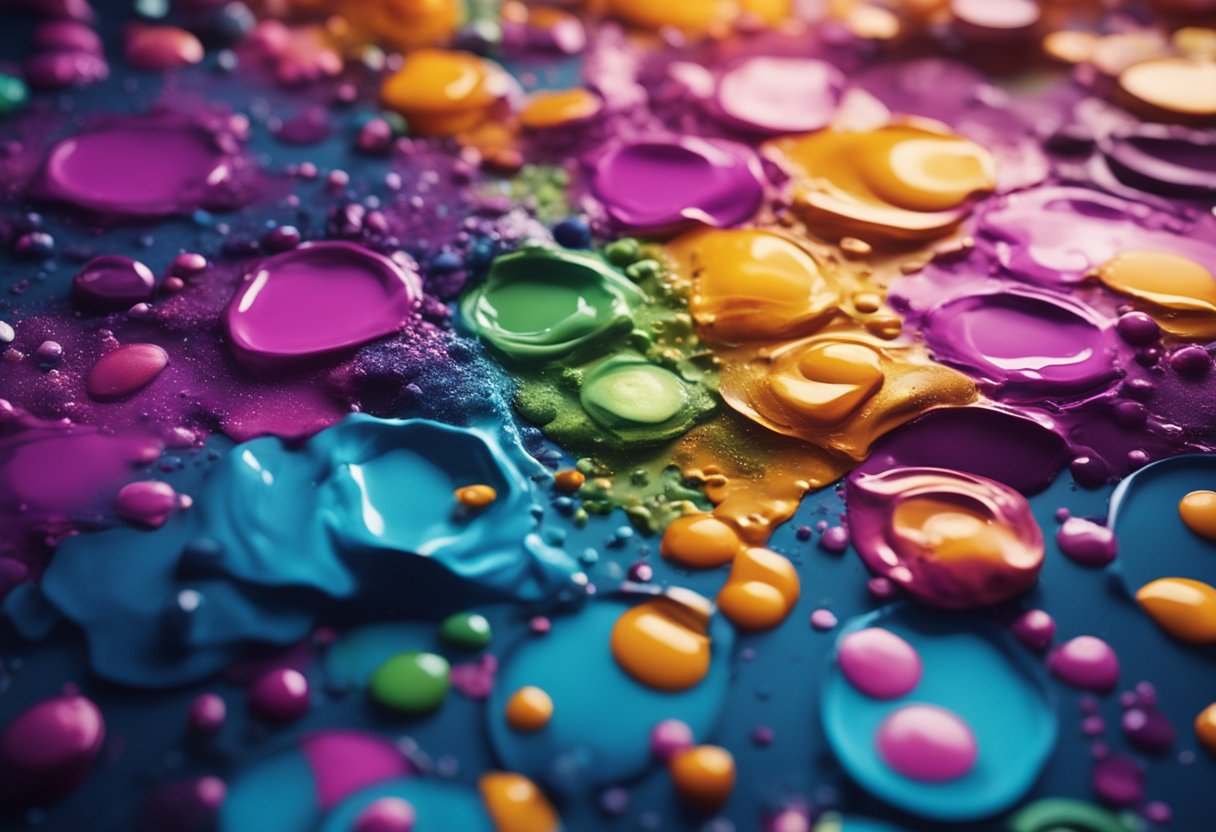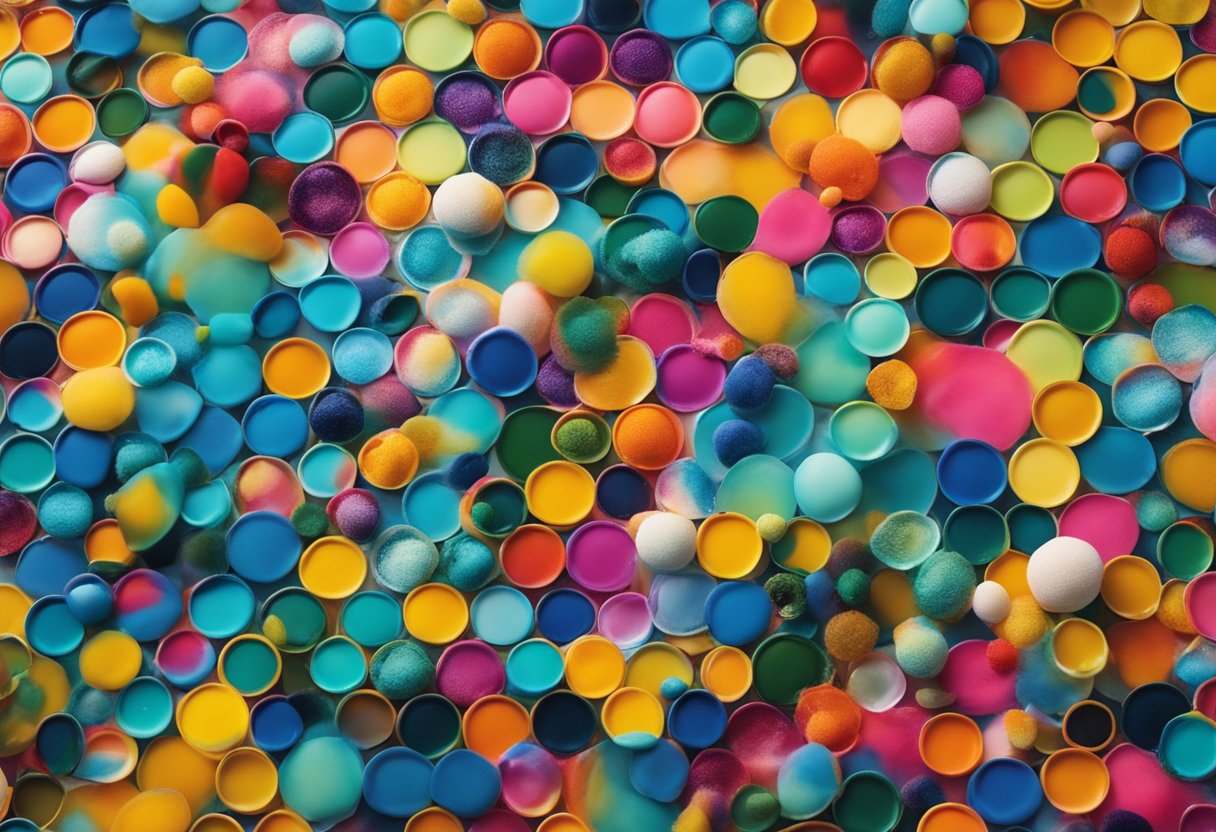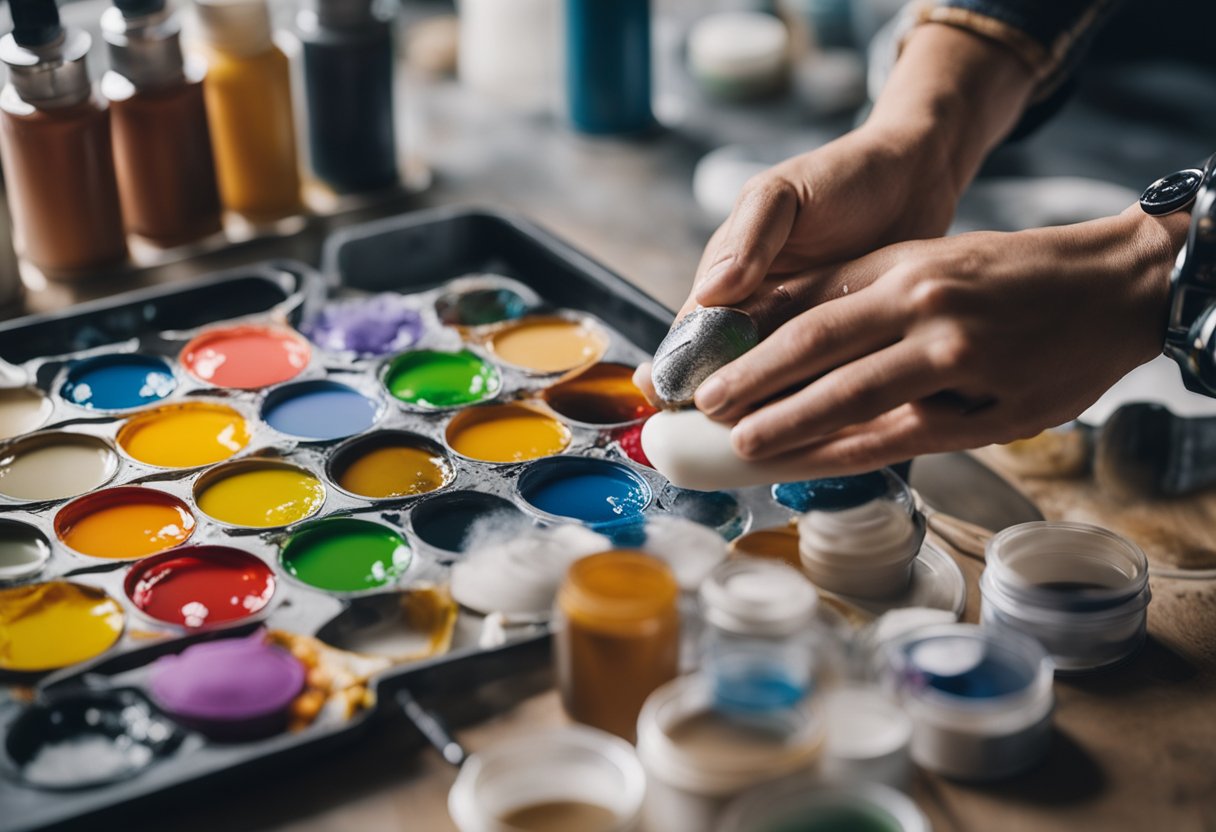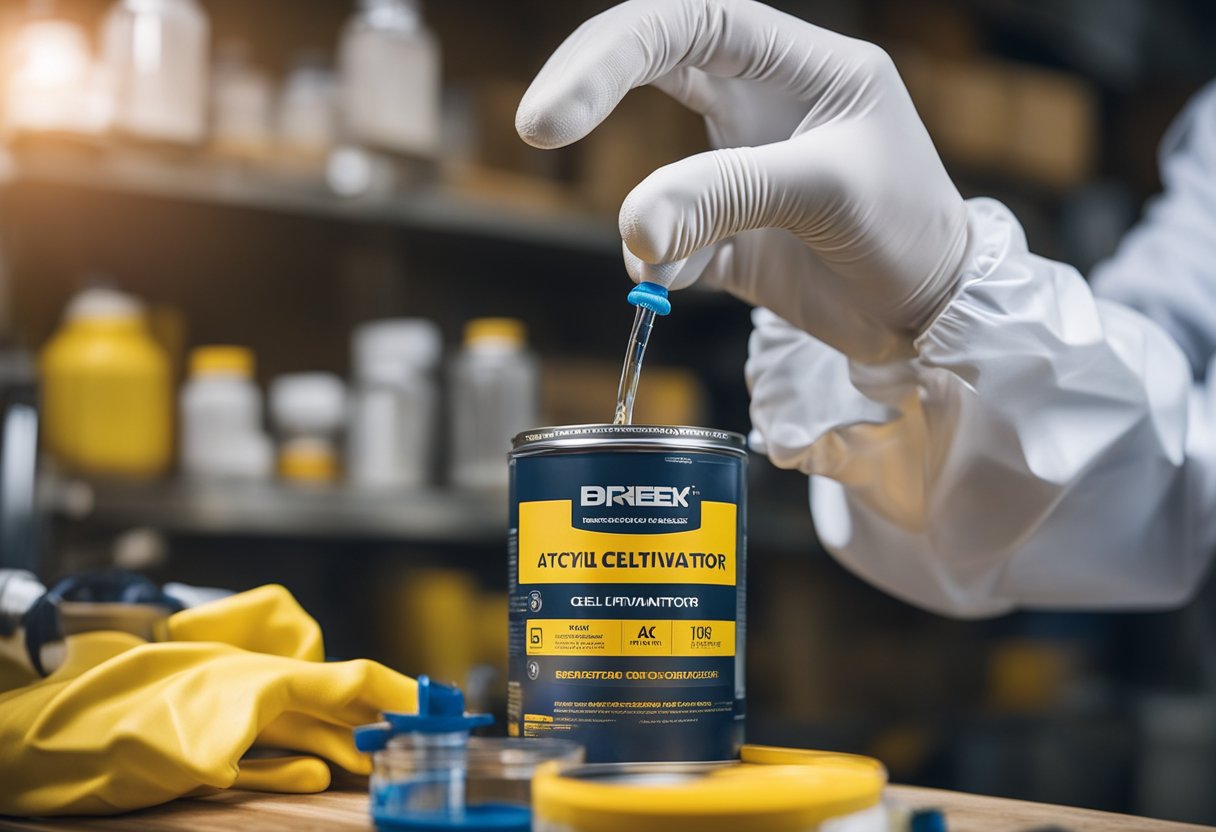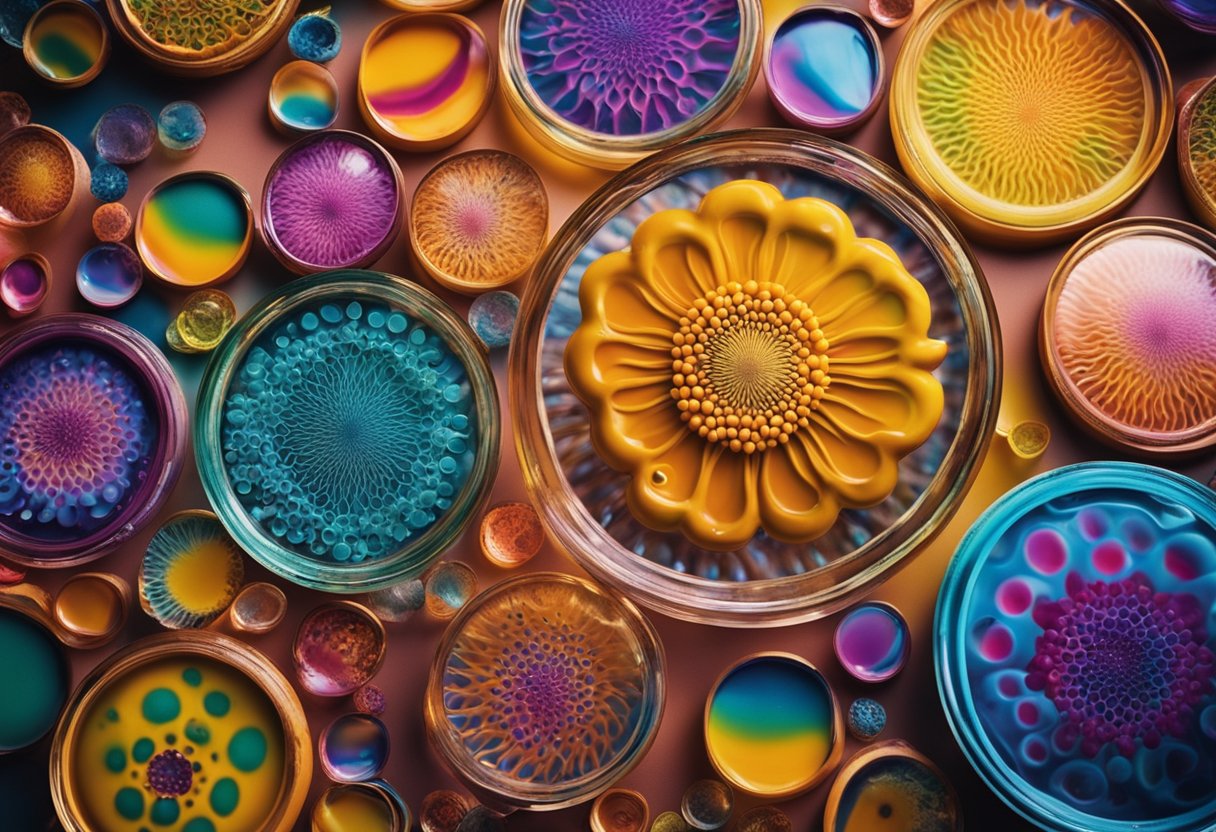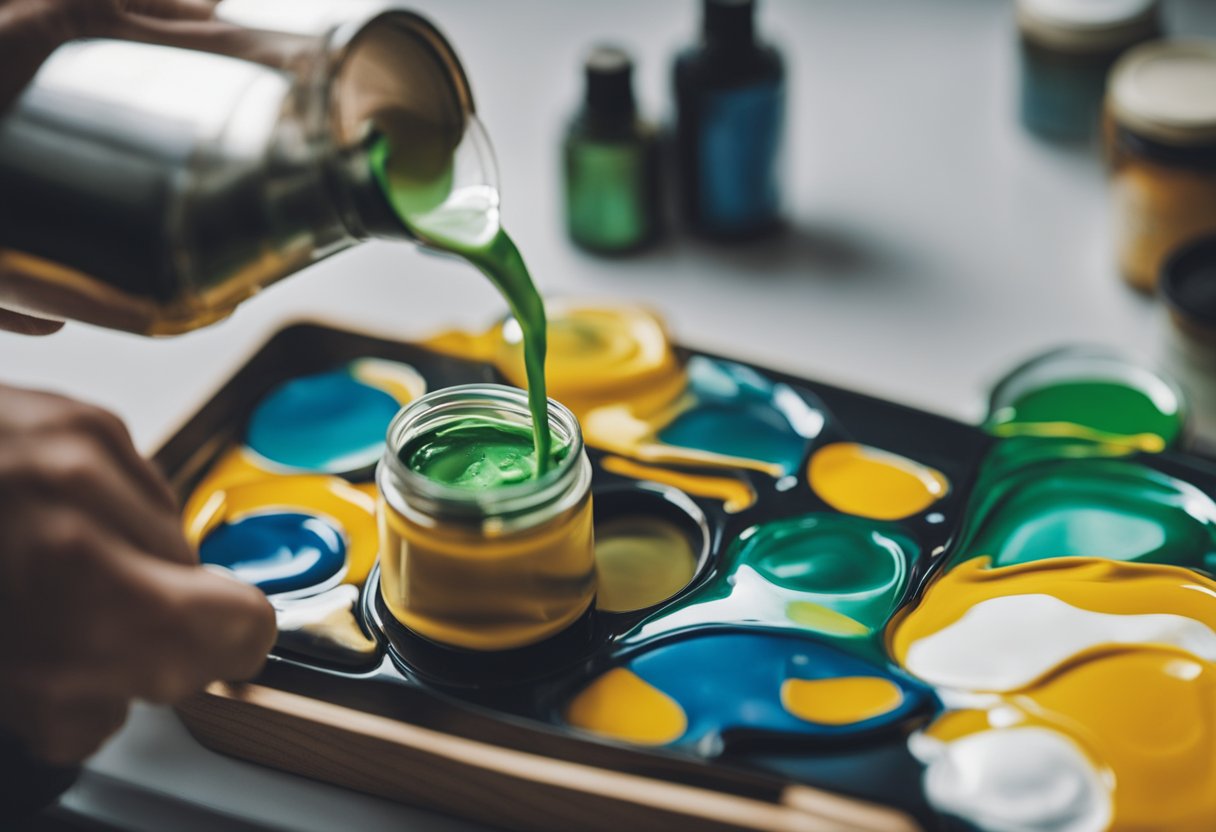Acrylic pouring is a popular art form that involves mixing acrylic paint with a pouring medium and creating unique designs on a canvas or other surface. One of the key techniques used in acrylic pouring is creating cells, which are circular or oval shapes that form when two or more colors of paint interact with each other. To create these cells, artists often use a material called cell activator.
Cell activator is an additive that is added to the acrylic paint mixture to help create cells. It is typically made from a combination of silicone oil, water, and a few other ingredients. When added to the paint mixture, the cell activator helps to create a reaction between the different colors of paint, causing them to separate and form cells. There are several different recipes for making cell activator, and artists often experiment with different ingredients and ratios to achieve the desired effect.
Key Takeaways
- Cell activator is an additive used in acrylic pouring to help create cells.
- Cell activator is typically made from a combination of silicone oil, water, and other ingredients.
- There are several different recipes for making cell activator, and artists often experiment with different ingredients and ratios to achieve the desired effect.
Understanding Acrylic Pouring
Acrylic pouring is a technique of painting where acrylic paints are mixed with a pouring medium to create a fluid consistency. This mixture is then poured onto a canvas or other surface to create a unique piece of art. One of the most fascinating aspects of acrylic pouring is the creation of cells.
Cells are patterns created by the reaction of different densities of paint. These patterns add visual interest and complexity to the artwork. The size and shape of the cells can be controlled by using different pouring techniques and cell activators.
Pouring medium is an essential component of acrylic pouring. It is a substance that is added to acrylic paint to increase its flow and consistency. The pouring medium also helps the paint to dry evenly without cracking or fading.
There are several pouring techniques used in acrylic pouring, including the dirty pour and flip cup. In the dirty pour technique, multiple colors of paint are mixed in a cup and then poured onto the canvas. The flip cup technique involves pouring the paint into a cup and then flipping it onto the canvas. Both techniques can create beautiful and unique patterns in the paint.
Specific gravity and density are important aspects of acrylic pouring. Different densities of paint will react differently when mixed, creating unique patterns and effects. It is important to maintain consistency in the mixture to ensure that the paint flows correctly and the cells are created evenly.
Creating a cell activator is an important step in acrylic pouring. A cell activator is a substance that is added to the paint mixture to create cells. Silicone oil is a popular choice for creating cells, but there are other options available as well. A detailed recipe for creating a cell activator can be found here.
Overall, acrylic pouring is a fascinating and exciting art form that allows for endless creativity and experimentation. By understanding the basics of pouring medium, pouring techniques, and cell activators, artists can create unique and beautiful pieces of art.
The Role of Cell Activator
https://www.youtube.com/watch?v=T2n0MyB39v4&embed=true
As an acrylic paint pouring enthusiast, I have found that cell activator is an essential ingredient in creating beautiful and unique paintings. Cell activator is an additive that is mixed with acrylic paint and pouring medium to create cells in the painting.
Cells are the circular or oval shapes that appear in acrylic paint pours, and they are created by the interaction of the paint and the cell activator. The size and shape of the cells depend on various factors, including the viscosity of the paint, the density of the cell activator, and the technique used to create the pour.
One of the scientific principles that govern the creation of cells is the Rayleigh-Taylor instability. This principle explains how the interaction between two fluids of different densities can lead to the formation of intricate patterns and shapes, such as the cells in an acrylic paint pour.
Silicone is the most popular additive used as a cell activator in acrylic pouring. It is a type of dimethicone that is added to the paint mixture to create cells. However, there are alternatives to silicone oil that can be used as a cell activator, such as 100% silicone or other oils.
In conclusion, the role of cell activator in acrylic painting is to create cells in the paint pour, which adds depth and texture to the painting. The size and shape of the cells depend on various factors, including the type of cell activator used and the technique used to create the pour. Silicone is the most popular additive used as a cell activator, but there are alternatives available. Understanding the science behind cell-making can help you create beautiful and unique paintings.
Materials and Additives
When it comes to creating beautiful cells in acrylic paint pours, the right materials and additives can make all the difference. As an experienced artist, I have experimented with a variety of materials and additives to achieve the best results.
Acrylic Paint
The first and most obvious material you will need is acrylic paint. Acrylic paint is a water-based paint that is easy to work with and dries quickly. It is available in a wide range of colors, including white, black, blue, and green. You can use any color of acrylic paint to create cells, but keep in mind that some colors may be more opaque than others.
Additives
There are several additives you can use to create cells in your acrylic paint pours. One of the most popular additives is Floetrol, a latex paint additive that helps to improve the flow and leveling of acrylic paints. Another popular additive is silicone oil, which helps to create cells by reducing the surface tension of the paint.
In addition to Floetrol and silicone oil, you can also use alcohol, such as isopropyl alcohol or rubbing alcohol, to create cells. Alcohol breaks down the surface tension of the paint, causing it to separate and form cells. You can also use water or distilled water to thin the paint and create cells.
For those who prefer natural additives, you can use treadmill lubricant or coconut milk to create cells in your acrylic paint pours. Treadmill lubricant is a silicone-based lubricant that can be used to create cells in place of silicone oil. Coconut milk can be used as a substitute for Floetrol, as it contains natural emulsifiers that help to improve the flow and leveling of acrylic paints.
Overall, the right materials and additives can help you create beautiful cells in your acrylic paint pours. Experiment with different combinations of materials and additives to find the perfect recipe for your desired effect.
The Art of Creating Cells
https://www.youtube.com/watch?v=eq8PMxlJdn8&embed=true
Creating cells in acrylic pouring is an art that requires a bit of knowledge and technique. Cells are distinct patterns created when different densities of paint react, adding visual interest and complexity to the artwork. They can be eye-catching, unique, and add depth and character to the painting.
One way to create cells is by using a cell activator. A cell activator is an additive added to acrylic paint, which helps create a special effect on the final piece of art. There are several routes one can use to come up with an effective cell activator. One popular option is to use silicone or another oil additive. Start by mixing your acrylic paint and pouring medium together. Once that is mixed well, add in your silicone drops.
Another way to create cells is by using heat. Torching or blow torching the painting can help create cells by popping air bubbles and moving the paint around. A torch can be used to create different textures, shapes, and sizes of cells, and can also add randomness to the painting. However, it’s important to be careful when using heat as it can also cause the paint to crack or bubble, and can be a fire hazard.
When creating cells, it’s important to pay attention to the directions in which the paint is moving. Different techniques can create different types of cells, such as circular or elongated cells. The amount of paint used and the mixing of colors can also impact the final result. Experimenting with different techniques and colors can help create unique and interesting cells in your painting.
In summary, creating cells in acrylic pouring is an art that requires a bit of knowledge and technique. Using a cell activator or heat can help create cells with different textures, shapes, sizes, and randomness. Paying attention to the directions of paint movement, amount of paint used, and mixing of colors can also impact the final result.
Safety and Precautions
When working with cell activators for acrylic paint, it is important to take certain safety measures to avoid any potential hazards. Here are some tips to ensure safe handling:
Protective Gear
Wearing protective gear is highly recommended when working with cell activators. This includes gloves, goggles, and a respirator mask. These items will protect your skin, eyes, and lungs from any harmful chemicals that may be present in the activator.
Torch
When using a torch to create cells in your acrylic pour, it is important to handle it with care. Keep the torch away from flammable materials and do not use it near an open flame. Also, make sure to turn off the torch after use and let it cool down before storing it away.
Heat
Avoid exposing cell activators to high temperatures or direct sunlight. This can cause the activator to evaporate or become unstable, leading to potential hazards. Store your activator in a cool, dry place away from heat sources.
Alcohol
Cell activators may contain alcohol, such as isopropyl alcohol or rubbing alcohol. These chemicals can be flammable and should be handled with care. Keep them away from heat sources and open flames. Also, make sure to properly dispose of any rags or materials that have come into contact with alcohol.
By following these safety precautions, you can ensure that your experience with cell activators for acrylic paint is both enjoyable and safe.
Tips and Techniques for Beginners
https://www.youtube.com/watch?v=f6hOwO_SgG0&embed=true
As a beginner in the world of acrylic painting, it can be overwhelming to learn about all the different techniques and materials available. Here are some tips and techniques to help you get started with using cell activator in your acrylic pours.
Practice and Research
Acrylic pouring with cell activator requires practice and research. It is essential to understand the materials and techniques involved in creating cells. With practice, you will develop your pouring skills and learn how to create different types of cells. Researching different pouring techniques and materials can help you find the best methods for creating the desired effect.
Patience and Creativity
Creating cells with acrylic pouring can take time, patience, and creativity. It is essential to take your time and not rush the process. Be patient while waiting for the cells to form and develop. Experiment with different methods and materials to create unique and creative effects.
Love-Hate Relationship
Acrylic pouring with cell activator can be a love-hate relationship. It can be frustrating when the cells do not form correctly, or the colors do not blend as you intended. However, it can also be incredibly satisfying when you create a beautiful piece of art. Embrace the process and enjoy the journey.
Avoid Distractions
When working on your acrylic pours, it is essential to avoid distractions. Turn off your phone and other electronic devices to help you focus on the task at hand. This will help you create a more focused and intentional piece of art.
Consider Your Audience
When creating art, it is essential to consider your audience. Think about who will be viewing your piece and what message you want to convey. This can help you choose the right colors, materials, and techniques to create the desired effect.
Utilize the Web
The internet is a valuable resource for learning about acrylic pouring with cell activator. There are many tutorials and resources available online that can help you learn new techniques and improve your skills. Take advantage of these resources to enhance your knowledge and creativity.
The Science Behind Cell Formation
As an artist, I am always fascinated by the science behind the formation of cells in acrylic paint pours. Cells are the distinct patterns that are created when different densities of paint react, adding visual interest and complexity to the artwork.
The formation of cells is caused by a phenomenon called the Rayleigh-Taylor instability, which occurs when two fluids of different densities are forced together. In acrylic pouring, this occurs when two or more colors of paint are layered on top of each other, and then tilted or manipulated to create movement.
The different densities of the paint cause the heavier paint to sink, creating a vertical pressure gradient. This pressure gradient causes the lighter paint to rise to the surface, creating a horizontal pressure gradient. The interaction between these two pressure gradients causes the formation of cells.
The specific gravity of the paint plays a significant role in the formation of cells. The specific gravity is the weight of a substance compared to the weight of an equal volume of water. The heavier the paint, the more likely it is to sink, creating the vertical pressure gradient that is necessary for cell formation.
Surface tension also plays a role in the formation of cells. Surface tension is the force that causes the surface of a liquid to contract. The surface tension of the paint helps to hold the cells in place and prevent them from blending together.
In conclusion, the science behind cell formation in acrylic pouring is fascinating and complex. It is caused by the interaction between different densities of paint, specific gravity, and surface tension. Understanding this science can help artists create beautiful and unique works of art.
Conclusion
In conclusion, I have learned that cell activator is an essential component in acrylic pouring. It helps to create beautiful cells and bubbles in the artwork. As an artist, I have found that using the right amount of cell activator can make all the difference in the final result.
Crafters and artists alike can benefit from using cell activator in their acrylic paint pouring. It is easy to make your own cell activator using ingredients such as silicone oil, alcohol, and water. Alternatively, you can purchase pre-made cell activator from art supply stores.
When using cell activator, it is important to remember to use it sparingly. Too much cell activator can result in overdeveloped cells and an unbalanced composition. It is also important to experiment with different pouring mediums and acrylic paint brands to find the perfect combination for your artwork.
Overall, cell activator is a versatile and valuable tool for creating unique and captivating acrylic paint pouring artwork. By incorporating cell activator into your creative process, you can achieve stunning results that are sure to impress.
Frequently Asked Questions
How can I create cells in acrylic paint without using a torch?
To create cells in acrylic paint without using a torch, you can try using alternative methods such as adding a cell activator or using a thicker consistency of paint. You can also try using a hairdryer or a straw to blow air onto the surface of the paint to create cells.
How can I make cells in pour painting without using silicone?
If you prefer not to use silicone in your pour painting, you can try using alternative additives such as dimethicone or coconut milk hair serum to create cells. You can also experiment with different pouring techniques, such as the flip cup or dirty pour method, to create cells without using silicone.
What is the recipe for making a Floetrol Cell Activator?
A popular recipe for making a Floetrol Cell Activator is to mix 1 part Floetrol with 2 parts water and a small amount of acrylic paint. Some artists also add a few drops of silicone oil to the mixture to enhance cell formation.
Can rubbing alcohol be used to create cells in acrylic paint?
Yes, rubbing alcohol can be used to create cells in acrylic paint. To use rubbing alcohol as a cell activator, simply mix a small amount of rubbing alcohol with your acrylic paint and pouring medium before pouring it onto your canvas.
Is Ambre Art Paint Cell Activator effective for creating cells?
Ambre Art Paint Cell Activator is a popular cell activator that many artists use to create cells in their acrylic pours. However, the effectiveness of the product may vary depending on the specific brand and the artist’s technique.
Why am I not getting cells in my acrylic pour?
There are several reasons why you may not be getting cells in your acrylic pour. It could be due to using the wrong consistency of paint or pouring medium, not using enough cell activator, or not properly mixing your paint. Experimenting with different techniques and additives can help you achieve the desired cell formation in your acrylic pours.

Hi, I’m Sal Muller of Tooltrip.com. My DIY experience led me to understand essential power tools for home projects. Tooltrip.com guides enthusiasts and professionals in choosing right tools for any job. I provide concise top tool reviews for easier, efficient DIY.

